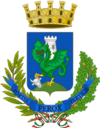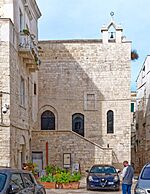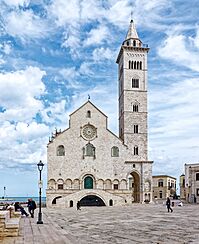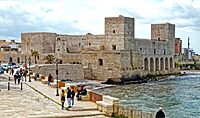Trani facts for kids
Quick facts for kids
Trani
|
|||
|---|---|---|---|
| Città di Trani | |||
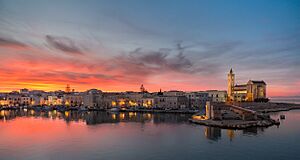
A view of Trani
|
|||
|
|||

Trani within the Province of Barletta-Andria-Trani
|
|||
| Country | Italy | ||
| Region | Apulia | ||
| Province | Barletta-Andria-Trani (BT) | ||
| Frazioni | Capirro | ||
| Area | |||
| • Total | 103.41 km2 (39.93 sq mi) | ||
| Elevation | 7 m (23 ft) | ||
| Population
(31 December 2017)
|
|||
| • Total | 56,031 | ||
| • Density | 541.833/km2 (1,403.34/sq mi) | ||
| Demonym(s) | Tranesi | ||
| Time zone | UTC+1 (CET) | ||
| • Summer (DST) | UTC+2 (CEST) | ||
| Postal code |
76125
|
||
| Dialing code | 0883 | ||
| Patron saint | Saint Nicholas the Pilgrim, Saint crucifix of Colonna | ||
| Saint day | June 2 | ||
Trani is a beautiful seaport city in Apulia, Southern Italy. It is located on the Adriatic Sea, about 40 kilometers (25 miles) northwest of Bari. Trani is one of the main cities in the Province of Barletta-Andria-Trani.
Contents
Trani's Long History
Early Beginnings of Trani
The city of Trani first appeared on an old Roman map called the Tabula Peutingeriana. This map was a copy from the 13th century. The name Trani might have come from the Greek hero Diomedes. Later, the city was ruled by the Lombards and the Byzantines. We know for sure that Trani was a settled city by the 9th century.
Trani's Golden Age in the Middle Ages
Trani was most important in the 11th century. It became a major church center, taking the place of Canosa. Its port was very busy, especially for ships going on the Crusades. It became the most important port on the Adriatic Sea.
In 1063, Trani created special rules for sea travel and trade. These rules, called the Ordinamenta et consuetudo maris, are the oldest sea laws we know of from Western Europe. Many important families from other Italian port cities like Amalfi and Venice came to live in Trani. Trani also had its own representatives, called consuls, in many cities across Europe. This shows how important Trani was for trade and politics during the Middle Ages.
Emperor Frederick II built a large castle in Trani. Under his rule in the early 13th century, Trani became very rich and successful.
Trani in Later Centuries
Trani saw some economic growth in the 1800s. By 1881, its population reached over 25,000 people. At this time, Trani was an important place for trading wines, fruits, and grain.
Jewish Community in Trani
Around 1159, a traveler named Benjamin of Tudela visited Trani. He found about 200 Jewish families living there. By the 12th century, Trani had one of the largest Jewish communities in Southern Italy. It was also the birthplace of a famous medieval rabbi, Rabbi Isaiah ben Mali di Trani. He was a very important writer and expert on Jewish law.
Later, the Jewish community in Trani faced difficult times. Many Jewish people were forced to leave. However, some historical buildings still remain. The Scolanova Synagogue is one example. After being used as a church for many centuries, it is now a synagogue again. The church of Sant'Anna was also once a medieval synagogue.
Trani's Location
Trani is located right on the Adriatic Coast. It is situated between the towns of Barletta and Bisceglie. Trani shares its borders with the towns of Andria, Barletta, Bisceglie, and Corato.
Main Sights to See in Trani
Even though Trani's old city walls are gone, its 13th-century fort has been fixed up. It is now a museum and a place for events. Many streets in the old Jewish Quarter (Ghetto) still look much like they did in the medieval period. You can see old Norman designs on many houses.
Trani Cathedral
The main church in Trani is Trani Cathedral. It is dedicated to Saint Nicholas the Pilgrim. He was a Greek man who died in Trani in 1094 while on his way to Rome. The cathedral stands on a high spot near the sea. It was started in 1143 and is built from beautiful white local limestone.
The cathedral has three rounded sections called apses. It also has a large underground area called a crypt and a tall tower. The tower was built between 1230 and 1239. The entrance arches are decorated with designs that show Arab influence. The bronze doors, made by Barisanus of Trani in 1175, are some of the best from that time in Southern Italy. The inside of the cathedral has been changed over the years. However, the crypt still looks much like it did originally.
Other Important Buildings
Near the harbor is the Gothic Palace of the Doges of Venice. This building is now used as a school for priests. The Church of Ognissanti was once a hospital chapel for the Knights Templar. It has a Romanesque carving of the Annunciation above its door. Other churches like San Giacomo and San Francesco also have Romanesque fronts. San Francesco and Sant'Andrea have Byzantine domes.
Trani's Economy
The area around Trani is known for producing excellent wine, especially Moscato di Trani. Other important products from Trani include figs, olive oil, almonds, and grain. These products are important for the city's trade.
Famous People from Trani
- Manfred (King of Sicily and son of Frederick II)
- Giovanni Bovio (philosopher and politician)
- Antonio Piccinni (painter)
- Rosalino Cellamare (singer)
- Emilio Covelli (anarchist and socialist)
- Leone di Lernia (singer)
- Jennie George (Australian politician and trade unionist)
- Domenico Sarro (composer)
- Riccardo Scamarcio (actor)
- Rabbi Isaiah ben Mali di Trani (a famous Jewish scholar and authority on Jewish law)
Images for kids
See also
 In Spanish: Trani para niños
In Spanish: Trani para niños



